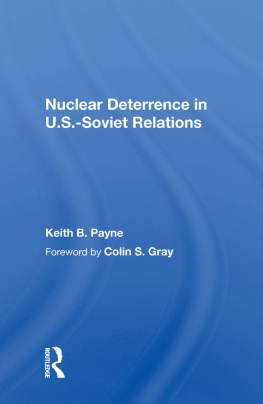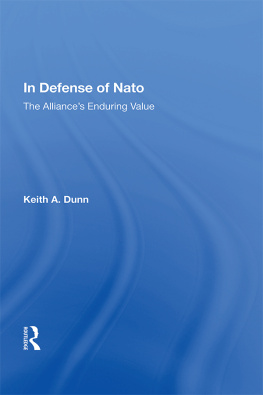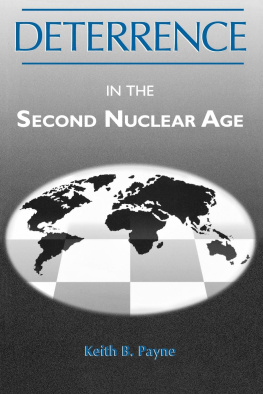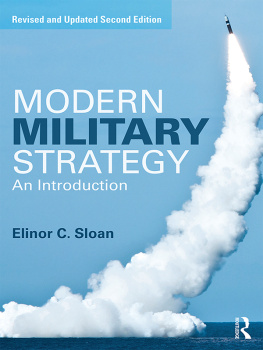MILITARY STRATEGY IN TRANSITION

Also of Interest from Westview Press
Nuclear Deterrence in U.S.-Soviet Relations, Keith B. Payne
Thinking About National Security: Defense and Foreign Policy in a Dangerous World, Harold Brown
The Half War: Planning U.S. Rapid Deployment Forces to Meet a Limited Contingency 1960-1983, Robert P. Haffa, Jr.
The Defense of the West: Strategic and European Security Issues Reappraised, edited by Robert Kennedy and John M. Weinstein
Defense Facts of Life: The Plans/Reality Mismatch , Franklin C. Spinney
U.S. Defense Planning: A Critique , John M. Collins
Laser Weapons in Space: Policy and Doctrine, edited by Keith B, Payne
NATO The Next Thirty Years: The Changing Political, Economic, and Military Setting, edited by Kenneth A. Myers
Maneuver Warfare and the Marine Corps , Richard Scott Moore and William S. Lind
U.S. Military Power and Rapid Deployment Requirements in the 1980s, Sherwood S. Cordier
Available in hardcover and paperback.
Studies in International Security Affairs and Military Strategy
Military Strategy in Transition: Defense and Deterrence in the 1980s
edited by Keith A. Dunn and William O. Staudenmaier
Current NATO military strategy is based on the policy of flexible response that U.S. and European politicians endorsed in 1967; for over 15 years, no fundamental changes in NATO's defense strategy have occurred. If NATO cannot stop a Warsaw Pact aggression conventionally, it continues to threaten a gradual and controlled nuclear escalation of both theater and strategic nuclear weapons.
Many analysts now question the fundamental principles underlying NATO's policy and strategy, given the enormous changes that have occurred in the strategic environment between 1967 and 1984. The contributors to this book examine the recent proposal by Samuel Huntington, who advocates that NATO adopt a conventional counter-retaliatory strategy based on offensive military actions deep into Eastern Europe. In evaluating this new proposal, the authors analyze the potential impact that it would have on U.S. and NATO military doctrine, assess probable European and Soviet reactions to NATO adopting a conventional counter-retaliatory strategy, and address the linkages existing between conventional and nuclear strategy. In the final chapter, the editors consider the policy, strategy, and force structure questions raised in the book and recommend policy options for the United States.
Keith A. Dunn is the senior policy analyst at the Strategic Studies Institute. William O. Staudenmaier is a colonel in the U.S. Army and director of strategy for the Center for Land Warfare, U.S. Army War College. They are coauthors of a forthcoming book, Strategic Implications of the Continental-Maritime Strategy Debate.
Military Strategy in Transition: Defense and Deterrence in the 1980s
Edited by
Keith A. Dunn
William O. Staudenmaier
To
Betty and Terry
First published 1984 by Westview Press
Published 2018 by Routledge
52 Vanderbilt Avenue, New York, NY 10017
2 Park Square, Milton Park, Abingdon, Oxon OX14 4RN
Routledge is an imprint of the Taylor & Francis Group, an informa business
Copyright 1984 by Taylor & Francis
All rights reserved. No part of this book may be reprinted or reproduced or utilised in any form or by any electronic, mechanical, or other means, now known or hereafter invented, including photocopying and recording, or in any information storage or retrieval system, without permission in writing from the publishers.
Notice:
Product or corporate names may be trademarks or registered trademarks, and are used only for identification and explanation without intent to infringe.
Library of Congress Catalog Card Number: 84-51615
ISBN 13: 978-0-367-01652-4 (hbk)
This volume evolved from a conference held in July 1983 at the US Army War College. The conference participants drawn from both the academic world and government were brought together to discuss a new concept for NATO that Samuel P. Huntington has proposed: namely, NATO should adopt a conventional retaliatory offensive military strategy.
In this volume, thirteen specialists on US strategy and military doctrine, the Soviet Union, and Europe analyze the conventional retaliatory proposal with particular attention given to the effects such a proposal would have upon US military strategy and alliance relations. During the conference four major themes developed and in their own way each author dealt with one or more of these themes:
- What is the nature of deterrence?
- How much emphasis should be put upon offensive doctrines, tactics, operational strategies, etc., when evaluating NATO military strategy?
- If NATO changes its military strategy, how will this affect not only the Alliance, but also the Warsaw Pact?
- Has the strategic environment changed so significantly that major alterations in NATO's strategy are required?
A summary of the contributors' major points are found in. In the concluding chapter we concentrate specifically upon the US policy, strategy, and force structure implications associated with adopting a NATO conventional retaliatory strategy. By way of preview, it is fair to say, we think, that very few of the contributors to this volume completely endorse the Huntington proposal. Nevertheless, they recognize that analyzing and discussing new alternatives for NATO is a healthy endeavor given the significant changes which have occurred in the strategic environment since NATO was formed in 1949.
Our grateful appreciation is extended to LTG Richard Lawrence, who was Commandant of the US Army War College when this conference was held. The idea of the conference was his and without his personal support it would not have been a success. We gratefully acknowledge the generous support provided by the US Army War College Foundation, Inc., and its Executive Director, Colonel LeRoy Strong, USA (Ret.). Special thanks Eire due to Deloris Hutchinson whose faithful efforts led to a completed manuscript. Also, we want to express our appreciation to the conference participants, who took time from their busy schedules to play an active role in the conference. Their comments helped the contributors sharpen their arguments in their final drafts. The conference participants are listed in the appendix. Working with the contributors has been a professional delight, and we would like to express our appreciation for their cooperation.
Neither this volume nor the individual articles in it should be construed to reflect the official position of the US Army War College, the Strategic Studies Institute, the Department of the Army, or the Department of Defense, unless so designated by other official documentation. The authors alone are responsible for any errors of fact or judgment.
Keith A. Dunn
William O. Staudenmaier
Carlisle Barracks, PA
Chapter 1
New Strategies, New Alternatives: Some Introductory Observations
by
Keith A. Dunn and William O. Staudenmaier
In recent years, US defense scholars of widely varying political persuasions have begun to question the basis of contemporary US military strategy. Among many observers, there is a growing belief that the strategic environment has changed dramatically and, as a result, traditional US policies and military concepts must be adjusted to meet the new realities of this dynamic environment, particularly with respect to the strategic consequences of superpower nuclear parity. This has led the strategic community to search for ways to break the nuclear stalemate by reexamining conventional strategies and by ending the long-term neglect of military operational issues. The alternative proposals range from major reductions in ground and air forces stationed in Europe to greatly expanded naval and maritime forces for Third World power projection missions. Some analysts favor a reduction in foreign policy commitments as a way to balance strategic requirements with defense resources. In philosophical terms, the alternatives range from adopting a strategic defensive approach where the United States attempts to reduce or limit its political and military commitments to favoring a global strategic offensive in which the United States is prepared to engage not only the USSR, but other potential adversaries simultaneously in different theaters of operations.















